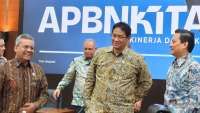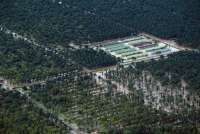CREDIT INTEREST RATE - JACKSON HOLE. Underscoring divisions within the Federal Reserve over how to respond to signs of a global economic slowdown, two officials on Thursday said they see no need to lower borrowing costs next month, while another said he was "open-minded."
Kansas City Fed President Esther George, who dissented against the U.S. central bank's decision to cut rates last month, and Philadelphia Fed President Patrick Harker, who said he "reluctantly" supported the rate cut, both said the U.S. economy does not need more stimulus at this point.
The July 31 quarter-point reduction in borrowing costs, the Fed's first cut in more than a decade, brought its key overnight lending rate to a target range of 2.00% to 2.25%. Investors widely expect another rate cut at the Fed's next policy meeting, on Sept. 17-18, and at least one more by the end of the year.
"I'd be happy to leave rates here, absent seeing either some weakness or some strengthening, some kind of upside risk that would cause me to think rates should be somewhere else," George said in an interview with Bloomberg TV.
Harker, meanwhile, told CNBC in a separate interview, "We should stay here for a while and see how things play out."
Speaking later in the day to CNBC, Dallas Fed President Robert Kaplan said the businesses he spoke to had become much more cautious given all the surprises on trade policy, even though consumer spending has been strong.
"I want to take all the time between now and September to assess how the economy is acting and I'd like to avoid having to take further action," said Kaplan, who supported the July rate cut. "If I see continued weakness, I'm going to at least be open-minded about making some adjustment."
Neither Harker nor Kaplan is a voting member of the Fed's policy-setting committee this year, but both participate in policy discussions.
The officials made their remarks on the sidelines of the Fed's annual central banking conference in Jackson Hole, Wyoming, amid broad concerns that the longest U.S. economic expansion on record may end because of the U.S.-China trade war, a global manufacturing slowdown and the possibility the Fed has set rates too high.
Yields on 2-year Treasury notes again rose above those on 10-year notes on Thursday, a "yield curve inversion" that is seen by some investors as a sign recession is on the way and that the Fed is taking too long to respond.
Economic data is sending contradictory signals. U.S. manufacturing industries recorded their first month of contraction in almost a decade in August, IHS Markit's Flash Purchasing Managers' Index showed on Thursday.
Still, the U.S. labor market, a key indicator in a consumption-led economy, seems healthy. Initial claims for state unemployment benefits dropped by 12,000 to a seasonally adjusted 209,000 for the week ended Aug. 17, the Labor Department said in a separate report. The decline was sharper than expected.
In their interviews on Thursday, George and Harker both described the yield curve as a signal they watch, but not one that was clearly pointing to a recession now.
"It's one signal among several," Harker said.
Kaplan said the fact that yields on U.S. government debt, including 10-year Treasuries, are now lower than the Fed's benchmark rate suggests that monetary policy is "a little tighter" than he would have thought three months ago.
FED UNDER PRESSURE
President Donald Trump, who has repeatedly accused the Fed of undercutting economic growth by keeping rates too high, said on Twitter that the economy "is doing really well," but that the central bank "can easily make it Record Setting."
Trump also said the escalating trade conflict with China was necessary despite research suggesting tariffs and the uncertainty they cause businesses were slowing growth.
The president is not alone in pressuring the Fed to cut rates after hiking rates four times in 2018. With markets betting on a rate cut next month, any disappointment that leads to a selloff could roil the economy further.
Yet the minutes from the Fed's July 30-31 policy meeting, released on Wednesday, revealed more opposition to the quarter-percentage-point rate cut than was reflected by the policy-setting committee's 8-2 vote.
George and Boston Fed President Eric Rosengren were the two voting panelists who dissented, wanting to hold rates steady.
But a "couple" of participants favored an even deeper half-percentage-point cut to help lift inflation toward the Fed's target and thwart fallout from global trade tensions. A larger number - characterized in the meeting minutes as "several" - favored no change at all.
Only a selection of Fed officials who participate in the rate-setting meetings get a vote.
Cleveland Fed President Loretta Mester, who is also not a voter on policy this year, told Reuters last week she had also opposed the recent rate cut but was still deciding what policy to recommend next.
/2019/03/19/1161668377p.jpg)









